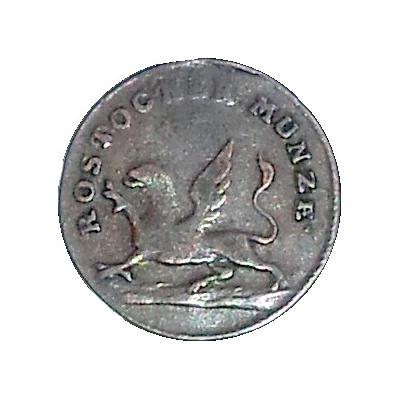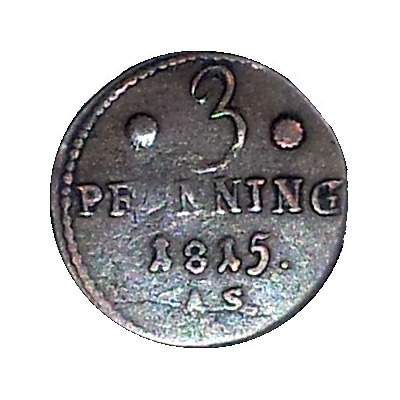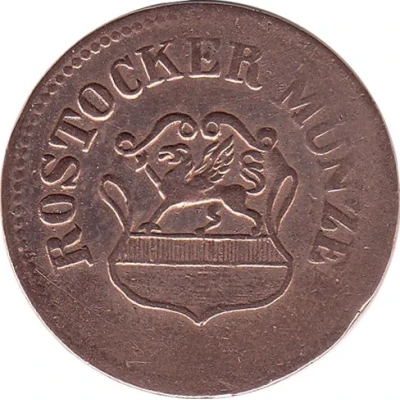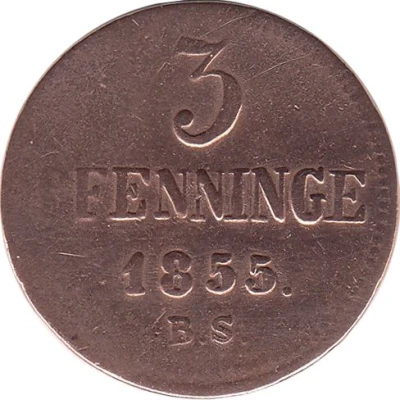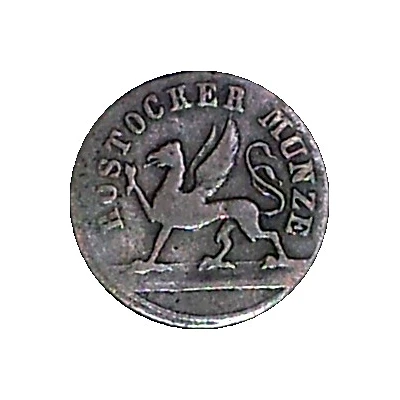
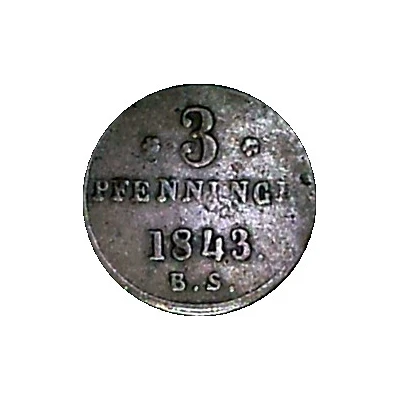

© Barlasov
3 Pfennigs
1843 year| Copper | 2.65 g | 20.9 mm |
| Issuer | City of Rostock (German States) |
|---|---|
| Period | Free city |
| Type | Standard circulation coin |
| Year | 1843 |
| Value | 3 Pfennigs (3 Pfennige) (1⁄96) |
| Currency | Thaler |
| Composition | Copper |
| Weight | 2.65 g |
| Diameter | 20.9 mm |
| Thickness | 0.92 mm |
| Shape | Round |
| Orientation | Medal alignment ↑↑ |
| Demonetized | Yes |
| Updated | 2024-10-05 |
| Numista | N#48679 |
|---|---|
| Rarity index | 73% |
Reverse
Denomination and date
Script: Latin
Lettering:
* 3 *
PFENNINGE
1843.
B.S.
Engraver: Benjamin Steinhorst
Edge
Plain
Comment
Rostock , officially the Hanseatic City of Rostock (German: Hansestadt Rostock), is the largest city in the German federal state of Mecklenburg-Western Pomerania and lies in the Mecklenburgian part of the state, close to the border with Pomerania.[a] With around 208,000 inhabitants, it is the third largest city on the German Baltic coast after Kiel and Lübeck, the eighth largest city in the area of former East Germany, as well as the 39th largest city of Germany. Rostock was the largest coastal and most important port city in East Germany.Rostock stands on the estuary of the River Warnow into the Bay of Mecklenburg of the Baltic Sea. The city stretches for about 16 km (10 mi) along the river, that flows into the sea in the very north of the city, between the boroughs of Warnemünde and Hohe Düne. The city center lies further upstream, in the very south of the city. While most of Rostock's inhabitants live on the western side of the Warnow, the area east of the river is dominated by the port, industrial estates and the forested Rostock Heath. The city's coastline east and west of the river mouth is relatively undeveloped, with long sandy beaches prevailing. The name of the city and of the river are of Slavic origin.
Rostock is the economic center of Mecklenburg-Western Pomerania and the state's only regiopolis. The port of Rostock is the fourth largest port in Germany after the North Sea ports of Hamburg, Bremen/Bremerhaven and Wilhelmshaven, and the largest port on the German Baltic coast. The ferry routes between Rostock and Gedser in Denmark as well as Trelleborg in Southern Sweden are among the busiest between Germany and Scandinavia. Rostock–Laage Airport lies in a rural region southeast of the city.
The city is home to the oldest university in the Baltic region and one of the oldest universities in the world, the University of Rostock, founded in 1419. The university's hospital, Universitätsmedizin Rostock, is one of two university hospitals in the state, along with Universitätsmedizin Greifswald of the University of Greifswald in Western Pomerania.
Interesting fact
The 3 Pfennigs 1843 coin from the City of Rostock (German States) is interesting because it was minted during a time of economic and political change in Germany. The coin was issued during the era of the German Confederation, a loose association of 39 German states that existed from 1815 to 1866. The coin's minting was likely a response to the growing need for a standardized currency across the German states, which previously had their own separate currencies. The use of copper as the material for the coin was also significant, as it reflected the value placed on copper as a durable and widely available metal for coinage during that time.
Price
| Date | Mintage | VG | F | VF | XF | AU | UNC |
|---|---|---|---|---|---|---|---|
| 1843 B.S. | 192000 | - | - | - | - | - | - |
Values in the table are based on evaluations by sales realized on Internet platforms. They serve as an indication only for 3 Pfennigs 1843 coin.
